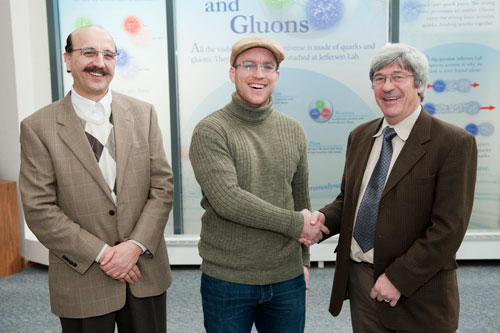
NEWPORT NEWS, VA. - Liquid crystals, used widely in LCD televisions and computer monitors, may play a prominent role in a device being designed by a University of Virginia researcher, who today was named the recipient of the 2011 JSA Postdoctoral Research Grant at the U.S. Department of Energy’s Thomas Jefferson National Accelerator Facility.
Mark Dalton, a research associate at UVa, plans to use the $11,000 grant to develop a so-called Kerr cell. The cell, which may include liquid crystals, will be used in a system to produce spinning electrons for a future experiment.
"It feels good; it's exciting. I think the work needs to be done, and I'm glad to have the opportunity to do it. And it's nice to be the master of the destiny of the project," Dalton said.
Dalton, who earned his B.S. and Ph.D. at the University of the Witwatersrand in Johannesburg, South Africa, was selected by the Users Group Board of Directors, the governing body of the group that represents scientists who use Jefferson Lab facilities to conduct nuclear physics research. In making the award, the board judged each applicant on his or her record of accomplishment in physics, proposed use of the research grant and the likelihood of further accomplishments in the Jefferson Lab research fields.
"The board was truly impressed with the overall quality of the proposals it received. It had to wrestle with a choice that was made especially hard by a lineup of outstanding and deserving young candidates that are active contributors to the physics mission of Jefferson Lab," said Zein-Eddine Meziani, board chairman and a professor at Temple University. "We had to choose a single winner, and in the end, the committee considered that Mark Dalton's proposal had a slight edge in the impact it will have for the overall science carried out at the lab."
Dalton is designing the Kerr cell for what is known as the MOLLER experiment. The experiment will require the delivery of a polarized electron beam -- one in which the spins of the electrons are mostly aligned in one direction. The experimenters must also be able to flip that polarization more rapidly and cleanly than the current equipment allows, which is the purpose of the Kerr cell.
"Kerr cells aren't commercially available, so we have to build one," Dalton explained. "It would be a chamber, and inside would be a gas or a liquid, such as liquid crystals, and there would be clear windows on either side, so that the light can get in and out."
Dalton said he'll spend the next year designing and building a prototype of the cell for testing.
"I would like to thank Kent Paschke [an assistant professor at UVa] for his excellent mentorship over the last few years, and the Users Group Board of Directors for supporting this important R&D initiative," Dalton said.
The JSA Postdoctoral Research Grant has been awarded annually since 2008 by the Users Group Board of Directors. The research grant is one of the funded projects of the JSA Initiatives Fund, a $0.5M program provided annually by the owners of JSA to support programs, initiatives, and activities that further the scientific outreach, and promote the science, education and technology missions of Jefferson Lab and benefit the Lab user community.
Contact: Kandice Carter, Jefferson Lab Public Affairs, 757-269-7263, kcarter@jlab.org

